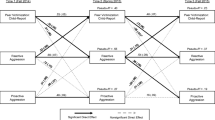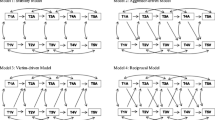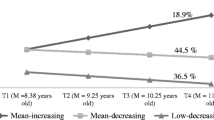Abstract
Previous research suggests that the prevalence of aggression is high among low-income urban youth who have to cope with a number of psychological stressors. Less is known about the early development and consequences of aggression and peer victimization prior to adolescence in these contexts. This study examined the correlates, interplay, and consequences of aggression and victimization among children in a low-income urban context. Data were collected in the spring of grades 1, 2, and 3. The final sample included 333 children (59.5 % girls, M = 6.46 years). Each year, children completed sociometric and peer assessments in their classrooms. A cross-lagged panel model with extended effects showed that aggression was relatively stable over time, whereas victimization was less stable. Aggression and victimization became increasingly less correlated over time. Further, early victimization negatively predicted later aggression for boys, but positively for girls. Growth curve modeling showed that initial aggression and victimization were associated with initial behavioral and relational problems. Early aggression, but not victimization, predicted relative stable or increasing in behavioral and relational problems over time. The results underscore the importance of a developmental perspective on early childhood aggression and victimization in high-risk contexts, in order to understand their implications for adjustment in adolescence.



Similar content being viewed by others
References
Arsenault, L., Walsh, L., Trzesniewski, K., Newcombe, A. C., & Moffit, T. E. (2006). Bullying victimization uniquely contributes to adjustment problems in young children. A nationally representative cohort study. Pediatrics, 118, 130–138. doi:10.1542/peds.2005-2388.
Attar, B. K., Guerra, N. G., & Tolan, P. H. (1994). Neighborhood disadvantage, stressful life events, and adjustment in urban elementary-school children. Journal of Clinical Child Psychology, 23, 391–400. doi:10.1207/s15374424jccp2304_5.
Barker, E. D., Boivin, M., Brendgen, M., Fontaine, N., Arsenault, L., Vitaro, F., et al. (2008). Predictive validity and early predictors of peer-victimization trajectories in preschool. Archives of General Psychiatry, 65, 1185–1192. doi:10.1001/archpsych.65.10.1185.
Bradley, R. H., & Corwyn, R. F. (2002). Socioeconomic status and child development. Annual Review of Psychology, 53, 371–399. doi:10.1146/annurev.psych.53.100901.135233.
Broidy, L. M., Brame, B., Fergusson, D., Horwood, J. L., Laird, R., Moffit, T. E., et al. (2003). Developmental trajectories of childhood disruptive behaviors and adolescent delinquency: A six-site, cross-national study. Developmental Psychology, 39, 222–245. doi:10.1037/0012-1649.39.2.222.
Bukowski, W. M., & Sippola, L. K. (2001). Groups, individuals, and victimization: A view of the peer system. In J. Juvonen & S. Graham (Eds.), Peer harassment in school: The plight of the vulnerable and victimized. New York: Guilford.
Camodeca, M., Goossens, F. A., Terwogt, M. M., & Schuengel, C. (2002). Bullying and victimization among school-age children: Stability and links to proactive and reactive aggression. Social Development, 11, 332–345. doi:10.1111/1467-9507.00203.
Card, N. A., Stucky, B. D., Sawalani, G. M., & Little, T. D. (2008). Direct and indirect aggression during childhood and adolescence: A meta-analytic review of gender differences, intercorrelations, and relations to maladjustment. Child Development, 79, 1185–1229. doi:10.1111/j.1467-8624.2008.01184.x.
Cicchetti, D., & Rogosch, F. (2002). A developmental psychopathology perspective on adolescence. Journal of Consulting and Clinical Psychology, 70, 6–20. doi:10.1037//0022-006X.70.1.6.
Cillessen, A. H. N., & Borch, C. (2006). Developmental trajectories of adolescent popularity: A growth curve modelling analysis. Journal of Adolescence, 29, 935–959. doi:10.1016/j.adolescence.2006.05.005.
Cillessen, A. H. N., & Mayeux, L. (2004). From censure to reinforcement: Developmental changes in the association between aggression and social status. Child Development, 75, 147–163. doi:10.1111/j.1467-8624.2004.00660.x.
Coie, J. D., & Dodge, K. A. (1983). Continuities and changes in children’s social status: A five-year longitudinal study. Merrill-Palmer Quarterly, 29, 261–282.
Coie, J. D., & Dodge, K. A. (1998). Aggression and antisocial behavior. In W. Damon & N. Eisenberg (Eds.), Handbook of child psychology; Vol. 3. Social, emotional, and personality development (pp. 779–862). New York: Wiley.
Coie, J. D., Lochman, J. E., Terry, R., & Hyman, C. (1992). Predicting early adolescent disorder from childhood aggression and peer rejection. Journal of Consulting and Clinical Psychology, 60, 783–792. doi:10.1037/0022-006X.60.5.783.
Coie, J. D., Terry, R., Lenox, K., Lochman, J. E., & Hyman, C. (1995). Childhood peer rejection and aggression as predictors of stable patterns of adolescent disorder. Development and Psychopathology, 7, 697–713. doi:10.1017/S0954579400006799.
Cote, S. M., Vaillancourt, T., LeBlanc, J. C., Nagin, D. S., & Tremblay, R. E. (2006). The development of physical aggression from toddlerhood to pre-adolescence: A nation wide longitudinal study of Canadian children. Journal of Abnormal Child Psychology, 34, 71–85. doi:10.1007/s10802-005-9001-z.
Crick, N. R., & Dodge, K. A. (1996). Social information-processing mechanisms in reactive and proactive aggression. Child Development, 67, 993–1002.
Dodge, K. A., Lochman, J. E., Harnish, J. D., Bates, J. E., & Pettit, G. S. (1997). Reactive and proactive aggression in school children and psychiatrically impaired chronically assaultive youth. Journal of Abnormal Psychology, 106, 37–51. doi:10.1037/0021-843X.106.1.37.
Dodge, K. A., Pettit, G. S., & Bates, J. E. (1994). Socialization mediators of the relation between socioeconomic status and child conduct problems. Child Development, 65, 649–665. doi:10.1111/j.1467-8624.1994.tb00774.x.
Dumas, J. E., Neese, D. E., Prinz, R. J., & Blechman, E. A. (1996). Short-term stability of aggression, peer rejection, and depressive symptoms in middle childhood. Journal of Abnormal Child Psychology, 24, 105–119. doi:10.1007/bf01448376.
Grant, K. E., Katz, B. N., Thomas, K. J., O’Koon, J. H., Meza, C., DiPasquale, A.-M., et al. (2004). Psychological symptoms affecting low-income urban youth. Journal of Adolescent Research, 19, 613–634. doi:10.1177/0743558403260014.
Hanish, L. D., & Guerra, N. G. (2002). A longitudinal analysis of patterns of adjustment following peer victimization. Development and Psychopathology, 14, 69–89. doi:10.1017/S0954579402001049.
Hawker, D. S. J., & Boulton, M. J. (2000). Twenty years’ research on peer victimization and psychosocial maladjustment: A meta-analytic review of cross-sectional studies. Journal of Child Psychology and Psychiatry, 41, 441–455. doi:10.1111/1469-7610.00629.
Hodges, E. V. E., Malone, M. J., & Perry, D. G. (1997). Individual risk and social risk as interacting determinants of victimization in the peer group. Developmental Psychology, 33, 1032–1039. doi:10.1037/0012-1649.33.6.1032.
Huesmann, L. R., Eron, L. D., Lefkowitz, M. M., & Walder, L. O. (1984). Stability of aggression over time and generations. Developmental Psychology, 20, 1120–1134. doi:10.1037/0012-1649.20.6.1120.
Juon, H. S., & Ensminger, M. E. (1997). Childhood, adolescent, and young adult predictors of suicidal behaviors: A prospective study of Blacks. Journal of Child Psychology and Psychiatry and Allied Disciplines, 38, 553–563. doi:10.1111/j.1469-7610.1997.tb01542.x.
Kempes, M., Matthys, W., Vries, H., & Engeland, H. (2005). Reactive and proactive aggression in children. A review of theory, findings and the relevance for child and adolescent psychiatry. European Child and Adolescent Psychiatry, 14, 11–19. doi:10.1007/s00787-005-0432-4.
Kochenderfer, B. J., & Ladd, G. W. (1996). Peer victimization: Cause or consequence of school maladjustment? Child Development, 67, 1305–1317. doi:10.1111/j.1467-8624.1996.tb01797.x.
Koeppel, M., & Bouffard, L. A. (2012). The long-term health consequences of bullying victimization. Retrieved September, 2012, from http://www.crimevictimsinstitute.org/publications/?mode=view&item=32.
Ladd, G. W., & Troop-Gordon, W. (2003). The role of chronic peer difficulties in the development of children’s psychological adjustment problems. Child Development, 74, 1344–1367. doi:10.2307/3696182.
Leadbeater, B. J., & Hoglund, W. L. G. (2009). The effects of peer victimization and physical aggression on changes in internalizing from first to third grade. Child Development, 80, 843–859. doi:10.1111/j.1467-8624.2009.01301.x.
Ledingham, J., Younger, A., Schwartzman, A., & Bergeron, G. (1982). Agreement among teacher, peer, and self-ratings of children’s aggression, withdrawal, and likability. Journal of Abnormal Child Psychology, 10, 363–372. doi:10.1007/bf00912327.
Malti, T., Perren, S., & Buchmann, M. (2010). Children’s peer victimization, empathy, and emotional symptoms. Child Psychiatry and Human Development, 41, 98–113. doi:10.1007/s10578-009-0155-8.
McLoyd, V. C. (1990). The impact of economic hardship on Black families and children. Psychological distress, parenting, and socioemotional development. Child Development, 61, 311–346. doi:10.1111/j.1467-8624.1990.tb02781.x.
Moffit, T. E. (1993). Adolescence-limited and life-course-persistent antisocial behavior: A developmental taxonomy. Psychological Review, 1000, 674–701. doi:10.1037/0033-295X.100.4.674.
Monks, C. P., Smith, P. K., & Swettenham, J. (2003). Aggressors, victims, and defenders in preschool: Peer, self-, and teacher reports. Merrill-Palmer Quarterly, 49, 453–469. doi:10.1353/mpq.2003.0024.
Morales, J. R., & Guerra, N. G. (2006). Effects of multiple context and cumulative stress on urban children’s adjustment in elementary school. Child Development, 77, 907–923. doi:10.1111/j.1467-8624.2006.00910.x.
Morrow, M. T., Hubbard, J. A., Rubin, R. M., & McAuliffe, M. D. (2008). The relation between childhood aggression and depressive symptoms: The unique and joint mediating roles of peer rejection and peer victimization. Merrill-Palmer Quarterly, 54, 316–340. doi:10.1353/mpq.0.0000.
Newcomb, A. F., Bukowski, W. M., & Pattee, L. (1993). Children’s peer relations: A meta-analytic review of popular, rejected, neglected, controversial, and average sociometric status. Psychological Bulletin, 113, 99–128. doi:10.1037/0033-2909.113.1.99.
Olweus, D. (1979). Stability of aggressive reaction patterns in males: A review. Psychological Bulletin, 86, 852–875. doi:10.1037/0033-2909.86.4.852.
Olweus, D. (1991). Bully/victim problems among schoolchildren: Basic facts and effects of a school-based intervention program. In K. H. Rubin & D. Pepler (Eds.), The development and treatment of childhood aggression (pp. 411–448). Hillsdale, NJ: Erlbaum.
Ostrov, J. M. (2010). Prospective associations between peer victimization and aggression. Child Development, 81, 1670–1677. doi:10.1111/j.1467-8624.2010.01501.x.
Poulin, F., & Boivin, M. (2000). Reactive and proactive aggression: Evidence of a two-factor model. Psychological Assessment, 12, 115–122. doi:10.1037/1040-3590.12.2.115.
Price, J., & Dodge, K. A. (1989). Reactive and proactive aggression in childhood: Relations to peer status and social context dimensions. Journal of Abnormal Child Psychology, 17, 455–471. doi:10.1007/bf00915038.
Reijntjes, A., Kamphuis, J. H., Prinzie, P., Boelen, P. A., Van der Schoot, M., & Telch, M. J. (2011). Prospective linkages between peer victimization and externalizing problems in children: A meta-analysis. Aggressive Behavior, 37, 215–222. doi:10.1002/ab.20374.
Reijntjes, A., Kamphuis, J. H., Prinzie, P., & Telch, M. J. (2010). Peer victimization and internalizing problems in children: A meta-analysis of longitudinal studies. Child Abuse and Neglect, 34, 244–252. doi:10.1016/j.chiabu.2009.07.009.
Rubin, K. H., Bukowski, W. M., & Laursen, B. (2009). Handbook of peer interactions, relationships and groups. New York: Guilford.
Rubin, K. H., & Daniels-Beirness, T. (1983). Concurrent and predictive correlates of sociometric status in kindergarten and Grade 1 children. Merrill-Palmer Quarterly, 29, 337–351.
Salmivalli, C., & Helteenvuori, T. (2007). Reactive, but not proactive aggression predicts victimization among boys. Aggressive Behavior, 33, 198–206. doi:10.1002/ab.20210.
Salmivalli, C., Karhunen, J., & Lagerspetz, K. M. J. (1996a). How do the victims respond to bullying? Aggressive Behavior, 22, 99–109. doi:10.1002/(sici)1098-2337(1996)22:2<99:aid-ab3>3.0.co;2-p.
Salmivalli, C., Lagerspetz, K., Björkqvist, K., Österman, K., & Kaukiainen, A. (1996b). Bullying as a group process: Participant roles and their relations to social status within the group. Aggressive Behavior, 22, 1–15. doi:10.1002/(sici)1098-2337(1996)22:1<1:aid-ab1>3.0.co;2-t.
Salmivalli, C., Lappalainen, M., & Lagerspetz, K. M. J. (1998). Stability and change of behavior in connection with bullying in schools: A two-year follow-up. Aggressive Behavior, 24, 205–218. doi:10.1002/(SICI)1098-2337(1998)24:3<205:AID-AB5>3.0.CO;2-J.
Scholte, R. H. J., Engels, R. C. M. E., Overbeek, G., de Kemp, R. A. T., & Haselager, G. J. T. (2007). Stability in bullying and victimization and its association with social adjustment in childhood and adolescence. Journal of Abnormal Child Psychology, 35, 217–228. doi:10.1007/s10802-006-9074-3.
Schwartz, D., Dodge, K. A., Coie, J. D., Hubbard, J. A., Cillessen, A. H. N., Lemerise, E. A., et al. (1998). Social-cognitive and behavioral correlates of aggression and victimization in boys’ play groups. Journal of Abnormal Child Psychology, 26, 431–440. doi:10.1023/A:1022695601088.
Schwartz, D., Proctor, L., & Chien, D. (2001). The aggressive victim of bullying. Emotional and behavioral dysregulation as a pathway to victimization by peers. In J. Juvonen & S. Graham (Eds.), Peer harassment in school: The plight of the vulnerable and victimized (pp. 147–174). New York: Guilford.
Singer, J. D., & Willet, B. W. (2003). Applied longitudinal data analysis: Modeling change and event occurrence. New York: Oxford University Press.
Storch, E. A., Bagner, D. M., Geffken, G. R., & Baumeister, A. L. (2004). Association between overt and relational aggression and psychosocial adjustment in undergraduate college students. Violence and Victims, 19, 689–700. doi:10.1891/vivi.19.6.689.66342.
Toblin, R. L., Schwartz, D., Hopmeyer Gorman, A., & Abou-Ezzeddine, T. (2005). Social-cognitive and behavioral attributes of aggressive victims of bullying. Journal of Applied Developmental Psychology, 26, 329–346. doi:10.1016/j.appdev.2005.02.004.
Tolan, P. H., Guerra, N. G., & Kendal, P. C. (1995). A developmental-ecological perspective on antisocial behavior in children and adolescents: Toward a unified risk and intervention framework. Journal of Consulting and Clinical Psychology, 63, 579–584. doi:0022-006X/95/S3.00.
Unnever, J. D. (2005). Bullies, aggressive victims, and victims: Are they distinct groups? Aggressive Behavior, 31, 153–171. doi:10.1002/ab.20083.
van Lier, P. A. C., & Crijnen, A. A. M. (2005). Trajectories of peer-nominated aggression: Risk status, predictors and outcomes. Journal of Abnormal Child Psychology, 33, 99–112. doi:10.1007/s10802-005-0938-8.
van Lier, P. A., Vitaro, F., Barker, E. D., Brendgen, M., Tremblay, R. E., & Boivin, M. (2012). Peer victimization, poor academic achievement, and the link between childhood externalizing and internalizing problems. Child Development, 83, 1775–1788. doi:10.1111/j.1467-8624.2012.01802.x.
Williford, A. P., Brisson, D., Bender, K. A., Jenson, J. M., & Forrest-Bank, S. (2011). Patterns of aggressive behavior and peer victimization from childhood to early adolescence: A latent class analysis. Journal of Youth and Adolescence, 40, 644–655. doi:10.1007/s10964-010-9583-9.
Acknowledgments
The first author was supported by a Research Assistant Grant from the Netherlands Royal Academy of Sciences. This research was supported by a grant from the University of Connecticut Research Foundation to the second author. The authors are grateful to the children, parents, and school administrators who made this research possible. In addition, the authors are grateful to William J. Burk for his assistance with the analyses.
LP participated in the design, performed the statistical analyses, interpretation of data and drafted the manuscript. AC participated in the design and coordination of the study, performed the data collection, helped to analyze the results, interpreted the data and helped to draft the manuscript. Both authors read and approved the manuscript.
Author information
Authors and Affiliations
Corresponding author
Rights and permissions
About this article
Cite this article
Pouwels, J.L., Cillessen, A.H.N. Correlates and Outcomes Associated with Aggression and Victimization Among Elementary-School Children in a Low-Income Urban Context. J Youth Adolescence 42, 190–205 (2013). https://doi.org/10.1007/s10964-012-9875-3
Received:
Accepted:
Published:
Issue Date:
DOI: https://doi.org/10.1007/s10964-012-9875-3




